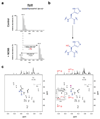Oxygenase-catalyzed ribosome hydroxylation occurs in prokaryotes and humans
- PMID: 23103944
- PMCID: PMC4972389
- DOI: 10.1038/nchembio.1093
Oxygenase-catalyzed ribosome hydroxylation occurs in prokaryotes and humans
Abstract
The finding that oxygenase-catalyzed protein hydroxylation regulates animal transcription raises questions as to whether the translation machinery and prokaryotic proteins are analogously modified. Escherichia coli ycfD is a growth-regulating 2-oxoglutarate oxygenase catalyzing arginyl hydroxylation of the ribosomal protein Rpl16. Human ycfD homologs, Myc-induced nuclear antigen (MINA53) and NO66, are also linked to growth and catalyze histidyl hydroxylation of Rpl27a and Rpl8, respectively. This work reveals new therapeutic possibilities via oxygenase inhibition and by targeting modified over unmodified ribosomes.
Conflict of interest statement
The authors declare no competing financial interests.
Figures



References
-
- Kaelin WG, Jr, Ratcliffe PJ. Mol Cell. 2008;30:393–402. - PubMed
-
- Klose RJ, Kallin EM, Zhang Y. Nat Rev Genet. 2006;7:715–27. - PubMed
-
- Webby CJ, et al. Science. 2009;325:90–3. - PubMed
-
- Hausinger RP. Crit Rev Biochem Mol Biol. 2004;39:21–68. - PubMed
-
- Loenarz C, Schofield CJ. Trends Biochem Sci. 2010;36:7–18. - PubMed
Publication types
MeSH terms
Substances
Associated data
- PubChem-Substance/144220794
- PubChem-Substance/144220795
- PubChem-Substance/144220796
- PubChem-Substance/144220797
- PubChem-Substance/144220798
- PubChem-Substance/144220799
- PubChem-Substance/144220800
- PubChem-Substance/144220801
- PubChem-Substance/144220802
- PubChem-Substance/144220803
- PubChem-Substance/144220804
- PubChem-Substance/144220805
- PubChem-Substance/144220806
- PubChem-Substance/144220807
- PubChem-Substance/144220808
- PubChem-Substance/144220809
Grants and funding
- 091857/WT_/Wellcome Trust/United Kingdom
- BB/D011523/1/BB_/Biotechnology and Biological Sciences Research Council/United Kingdom
- BB/G014124/1/BB_/Biotechnology and Biological Sciences Research Council/United Kingdom
- 091857/Z/10/Z/WT_/Wellcome Trust/United Kingdom
- CRUK_/Cancer Research UK/United Kingdom
LinkOut - more resources
Full Text Sources
Other Literature Sources
Molecular Biology Databases

